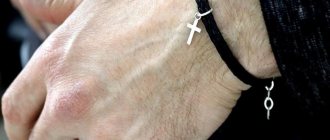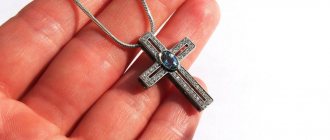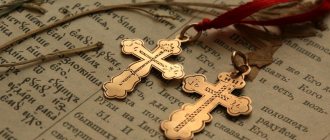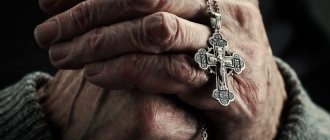If you ask any person, even those far from religion, what symbol comes to mind when they hear the word “Christianity,” he will answer: “cross.” But if he talks about the difference between intra-confessional movements, he will probably experience serious difficulties.
What can I say: few people who call themselves Orthodox will be able to identify a cross that corresponds to the church structure. Well, not all Christians come to church as devout believers and versed in the nuances of theology - many are baptized only following fashion.
However, each of us has freedom of conscience and is free to choose our own path to God. And we will help you take a small step towards him and tell you about the rules for choosing a pectoral cross.
The most important thing: the correct Orthodox cross must be consecrated in the church and personify faith in the feat of Jesus. Everything else is small nuances, of little significance to a true believer!
Symbolism of the Christian cross
To understand why wear a cross, you need to understand the meaning of the main Christian symbol - the cross. Orthodoxy teaches that 2 thousand years ago the incarnate God Jesus Christ was crucified on a cross-shaped pillar. This was a common type of execution in the Roman Empire. By His voluntary Sacrifice and subsequent Resurrection, the Lord freed humanity from the captivity of sin and spiritual death. The Creator returned to us the opportunity to inherit the Kingdom of Heaven, lost after the fall of Adam and Eve. Venerable Macarius the Great teaches:
“[Christ] came and took away the sin of the world... made a great and saving atonement and healing of the [human] soul. He freed her from slavery and brought her out of darkness, glorifying her with His own light.”
Orthodox pectoral cross
The cross is revered by Christians as a sacred symbol of the redemptive voluntary death of the Savior. As evidence of His immeasurable love and mercy for a lost person. The Holy Fathers call the cross a hard-won trophy of victory over evil and death. This is a sign of Truth and future immortality, the key to the gates of God's Kingdom. Through veneration of the cross we worship the Lord Himself. Let us quote the words of St. John Chrysostom:
“Previously, the cross served as a name for punishment, but now it has become an object of veneration. Previously it was a symbol of condemnation, but now it is a sign of salvation... He freed us from error, enlightened those sitting in darkness... reconciled us with God.”
Christians cross themselves with a cross in prayer, place it on the domes of churches, and wear a cross around their neck. Any reverent inscription of this symbol carries holiness and drives away dark spirits. Saint Demetrius of Rostov notes:
“Displaying miraculous power, any Cross does not act by itself, but by the power of Christ crucified on it and by invoking His Most Holy Name.”
What does the inscription NIKA on the cross mean?
Any educated person will say that “Nika” translated from Greek means “victory.” That, by the way, was the name of the ancient Greek goddess of victory, a close relative of the ancient Roman Victoria. So why is the name of a pagan goddess often emblazoned on Orthodox crosses?
So, the word NIKA on the cross means “victory.” According to historical chronicles, crosses with the initials of the Savior and the word “Nike” were installed in Byzantium by Emperor Constantine. This was done in honor of the victory over the Roman emperor Marcus Aurelius and marked the triumph of the new faith. Now this inscription is interpreted more simply: the Savior atoned for human sins and conquered death itself.
The main thing in an Orthodox cross is not its shape or market value, but its spiritual content. And they are endowed with symbols of faith exclusively by the people who wear and venerate them!
06.04.21
Why wear a cross
A personal cross is given to an Orthodox Christian in the Sacrament of Baptism. It is in this sacred rite that a person gets rid of the power of sin and becomes a Christian, a member of the Church. Saint Gregory the Theologian teaches:
“The grace and power of Baptism cleanses sin in every person and completely washes away all uncleanness and defilement brought by corruption [original sin].”
The connection between the cross and Baptism does not lie in the consonance of these words. In the literal sense, this Sacrament is not connected with the main symbol of Christianity. Their connection is spiritual and semantic.
Is it necessary for baptized people to wear a cross around their neck? It is given for constant wear, since it serves as evidence of the faith of the person being baptized and his devotion to the Lord. This is a sacred reminder of Christ's Redemptive Sacrifice. Without Her, the spiritual cleansing that Gregory the Theologian speaks of would not have been possible.
The cross is also our personal weapon against evil forces. Demons are conscious apostates and enemies of God. Therefore, they cannot bear the grace of the symbol of the commonwealth of man and the Creator. Archpriest Igor Fomin notes:
“The meaning of wearing a cross is multifaceted. This is also evidence of our faith. And the protection of our lives with the instrument of Salvation. And a reminder that the Lord loves us so much that He gave His only begotten Son, so that He, having endured the suffering of the Cross, would give us the opportunity to enter the Kingdom of Heaven.”
Priests warn against blasphemous attitude towards the pectoral cross. This is a shrine, not a fashion accessory. And not a magical amulet designed to automatically help everyone who puts it on. The cross will not serve for the benefit of a person who does not have genuine faith, repentance and the desire to live according to the Gospel commandments.
What does the skull on the cross mean?
It would seem that before us is a symbol of salvation and the triumph of life, so why is a skull and crossbones sometimes depicted below on a cross? This cannot be some kind of mystical symbol, because the Christian Church has a negative attitude towards occult knowledge.
Some people associate this image with a reminder of the frailty of earthly life. But there is a better version. According to legend, it was on Golgotha, where Christ suffered martyrdom, that the remains of the first man, Adam, rest. And the blood of the Savior washed the land of the Place of Execution, at the same time washing away the sins of human ancestors.
History of the pectoral cross
In the 4th century in Jerusalem, the miraculous discovery of the Holy Cross by the holy Queen Helen took place. Then widespread veneration of this blessed symbol began, including through wearing it on the body. Later, crosses began to depict the crucified Lord. In the Middle Ages, He was often represented in a different form - blessing or sitting on a throne.
In Rus', the first pectoral crosses appeared in the middle of the 10th century, even before the official adoption of Christianity (988). They were worn by individual Christians who converted to Orthodoxy earlier than other compatriots, “on their own initiative.” After the Baptism of Rus', crosses were worn for some time on top of clothes to publicly declare their faith. Later it became customary to hide the shrine from prying eyes. After all, true faith is manifested not by external attributes, but by life and deeds. Protodeacon Sergius Shalberov, speaking about whether it is necessary to wear a cross, notes:
“Wearing a cross is, first of all, a manifestation of personal piety. But historically it turned out that this custom became familiar and became the norm of Christian life. And the absence of a cross began to be regarded as a sin and a departure from the faith.”
During periods of atheistic persecution, many Christians suffered and became holy martyrs for refusing to take off their cross and renounce Christ. The Slavs had a pious custom of exchanging personal crosses as a sign of brotherly love and fidelity.
LiveInternetLiveInternet
Quote from message ALLA_KORN
Read in full In your quotation book or community!
A pectoral cross - why is it worn on the body and is it possible to remove the cross from oneself?
A pectoral cross - why is it worn on the body and is it possible to remove the cross from oneself?
BODY CROSS
Of all the world religions, Christianity occupies a special position in Russia. According to statistics, at least two thirds of Russians have received the Sacrament of Baptism. In this Sacrament, among other actions, a pectoral cross is placed on a person’s neck. About where the tradition of wearing crosses on the body came from, why it is worn on the body and whether it is possible to remove the cross from oneself - this and other things will be discussed in our article.
A little history
The custom of placing a pectoral cross on the neck of the newly baptized person along with Baptism did not appear immediately. However, the cross as an instrument of salvation has been the subject of greatest celebration among Christians since the very foundation of the Church. For example, the church thinker Tertullian (II–III centuries) in his “Apology” testifies that the veneration of the cross existed from the first times of Christianity. Even before the discovery of the life-giving cross on which Christ was crucified in the 4th century by Queen Helena and Emperor Constantine, the custom was already widespread among the first followers of Christ to always have an image of the cross with them - both as a reminder of the suffering of the Lord, and to confess their faith before others . From the acts of the 7th Ecumenical Council (Act 4) we know that the holy martyrs Orestes (suffered c. 304) and Procopius (martyred in 303) wore a cross on their chests. Pontius, the biography of the holy martyr Cyprian of Carthage (d. 258), and others also write about this custom. Christians wore an image of a cross on their bodies, most often on their foreheads and chests. If some Christians wore a cross under their clothes out of fear of persecution or out of a reverent desire to avoid ridicule of the shrine by pagans, then there were others who wanted to confess Christ and their faith. Such a bold and decisive confession prompted the image of a cross to be placed on the forehead as the most prominent place on the human body. Today very few external sources have survived that would report on this pious tradition of wearing the cross, because in the first three centuries it belonged to the area of disciplinae arcanae, that is, to the circle of those Christian beliefs and rituals that were kept secret from the pagans. After the weakening and subsequent cessation of the persecution of Christians, wearing a cross became a widespread custom. At the same time, crosses began to be installed on all Christian churches. In Rus', this custom was adopted precisely with the baptism of the Slavs in 988. On Russian soil, crosses were worn not on the body, but on top of clothing, “as clear indicators of Christian baptism.” They were called encolpions - from the Greek word for “chest”. Encolpions first had the shape of a four-sided box, empty inside; on their outer side there was an image of a monogram of the name of Jesus Christ, and later - a cross of various shapes. Particles of relics were kept in this box.
The meaning of the cross
What does a pectoral cross symbolize and why is it necessary to wear it? The cross, as an instrument of terrible and painful execution, thanks to the sacrificial deed of Christ the Savior, became a symbol of redemption and an instrument of salvation for all mankind from sin and death. It is on the Cross, through pain and suffering, death and Resurrection, that the Son of God accomplishes the salvation or healing of human nature from mortality, passion and corruption introduced into it by the fall of Adam and Eve. Thus, a person who wears the Crucifixion of Christ testifies to his participation in the suffering and feat of his Savior, followed by hope for salvation, and therefore the resurrection of a person for eternal life with God. This participation consists not so much in theoretically recognizing that Christ once, more than two thousand years ago, suffered physically and morally in Jerusalem, but in accepting: I, just like the Lord, am ready to offer daily sacrifice yourself - through the struggle with your passions, through forgiveness and non-judgment of your neighbors, through building your life according to the Gospel commandments of the Savior - as a sign of love and gratitude to Him.
A huge honor
For an Orthodox Christian, wearing a cross is a great honor and responsibility. Conscious disregard and blasphemous attitude towards the cross among the Russian people has always been understood as an act of apostasy. Russian people swore allegiance on crosses, and by exchanging pectoral crosses, they became cross brothers. When building churches, houses, and bridges, a cross was laid in the foundation. The Orthodox Church believes that through a person’s faith, the power of God is manifested (acted) in an invisible way through the cross of Christ. The cross is a weapon against the devil. The Church can reliably speak about the miraculous, saving and healing power of the cross and the sign of the cross, citing experience from the lives of its saints, as well as numerous testimonies of ordinary believers. Resurrection of the dead, healing from illnesses, protection from evil forces - all these and other benefits to this day through the cross show God’s love to man.
Worthless superstitions
But despite the life-giving power of the cross, many people believe (follow) various superstitions associated with the cross. Here is an example of one of them: “Seeing a pectoral cross in a dream is an alarming sign, and if you dreamed that you had lost a cross, be prepared for troubles that will not be slow to fall on you,” dream interpreters unanimously say. But the most common superstition associated with the Crucifixion tells us that if we find somewhere a cross lost by someone, then we cannot take it, since by doing so we are taking on the sins of others. However, when it comes to finding lost money, no one remembers the sins of others, especially the pain of others. And to the “serious question” that worries many people about what it means when a cross is lost, I would like to answer just as seriously that it means that the chain or rope on which this cross hung was broken. The presence in a person of a superstitious, that is, vain, empty attitude towards the cross testifies to a lack of faith and even distrust of Christ, and therefore of His redemptive sacrificial feat accomplished on the Cross. In this case, hope and love for God and trust in God's Providence are replaced by distrust and fear of the unknown.
Dubious goals
For what purpose are crosses worn today and are they worn at all? Here are the answers to this question that were posted on one of the Internet forums: • I wear it as a talisman; • because it’s beautiful and probably just helps; • I wear a cross, but not as a symbol of faith, but as a gift from someone close to me; • I wear it because, they say, it brings happiness; • I don’t wear it, because I consider it idolatry; there is no indication of this custom in the Bible; • I don’t wear a cross for two reasons: my neck itches terribly from all these chains, and secondly, I, of course, am a believer, but not to the same extent... This is exactly what unchurched people with a pagan, or even consumerist, attitude towards faith and religion. But among this type of people there is a part that does not accept wearing a cross at all, citing the following reason: “God is already in my soul”; “In the Bible, God does not command you to wear a cross”; “The cross is a symbol of death, a shameful instrument of execution,” etc. What can a person come up with as an excuse for his elementary ignorance in the field of Christian culture! Thus, most unchurched people do not have a Christian understanding of what a cross is and why it should be worn on the body. The Church says that the cross is a shrine on which the salvation of people was accomplished, testifying to God’s love for us. Upon acceptance of the Sacrament of Baptism, a person begins to be called a Christian, which means one who is ready to testify to loyalty to God with his whole life through bearing his life’s cross and following His commandments. This is precisely what the image of the cross on our chest constantly reminds us of. Orthodox Christians are called upon to look at the cross and treat it with great reverence and responsibility. Such reverent attitude towards the cross and remembering it as a shrine often keeps a person from committing a bad act. It is not for nothing that in Rus' a person who committed a crime was told: “You have no cross.” This phrase does not carry the literal, physical meaning of the absence of a cross on the body, but speaks of a lack of remembrance, a serious Christian attitude towards the cross and the Christian faith. In itself, the presence of a cross on the chest does not save and has no meaning for a person if he does not consciously profess what the Cross of Christ symbolizes. A reverent attitude towards the body cross encourages a believer not to remove the cross from the body unless seriously necessary. The fact that in Rus' they made special bath crosses from wood, so as not to get burned by a metal cross, suggests that people did not want to remove the crosses even for a short time (during washing). No wonder the Russian people said: “He who has a cross is with Christ.” But there are situations when certain circumstances require it - for example, operations on the body. In such cases, you should not neglect the doctor’s request; it is enough to sign yourself with the sign of the cross and rely on the will of God. The question of whether or not to put crosses on infants causes fear in many people, because the child allegedly could be strangled by the rope or chain on which the Crucifix is located. But there is not yet a single known accident in which a child strangled himself with his own hands or inflicted wounds on himself with a cross. These are just vain fears or superstitious prejudices of adults. My only advice to parents is that they should not put too long a rope or chain around their children’s necks. Conclusion The cross is not just a memory of the day of baptism and not a relic that should be kept, not a talisman or a gift, but a shrine through which God gives a believer who leads a correct spiritual life His grace, consolation and support. It is no coincidence that the Russian people have put together a wise proverb: “We do not bear the cross, but it bears us.” Being a visible shrine, the pectoral cross is designed to testify to our faith in Christ, our readiness to sacrificially love and forgive people and live according to the Gospel commandments. And may God grant us, looking at our cross, to more often remember the words of the Lord and act according to His call: “If anyone wants to come after Me, let him deny himself and take up his cross and follow Me” (Matthew 16:24).
Deacon Konstantin Kiosev Source: “Orthodoxy” website
Pectoral cross: rules of circulation and common misconceptions
The pectoral cross of an Orthodox Christian must be of a canonical shape (4, 6 or 8 ends) and consecrated. There is no special canonical teaching of the Church on wearing the cross. However, as already mentioned, traditionally the shrine is not worn for show, but under clothing.
The cross can be wooden or metal, on a string or a chain - it doesn’t matter. The main thing is to wear it with faith and reverence. It is not customary to remove the cross in everyday circumstances (when bathing, changing clothes, etc.). This is acceptable in special situations, such as during medical procedures. You don’t have to wear the same cross your whole life; you can change it. It is also not forbidden to give this shrine or receive it as a gift.
Archpriest Nikolai Markovsky warns against superstitions associated with the pectoral cross. For example, some people are convinced that dropping or losing it will bring bad luck. The priest notes:
“People work, rush about business, play sports. It may happen that a person loses his pectoral cross. You can't attach any significance to this. You need to buy another one from the icon shop. Put on a new one and wear it with faith and prayer.”
If the cross on the neck has darkened, it means that the metal has oxidized. One should not look for mysticism in this either. Another example of superstition: supposedly you cannot pick up, much less carry, a cross that someone has lost. It is believed that this will change fate and “hang” other people’s sins on a person. Father Nikolai reminds us that in Christianity there are no concepts of predestination and fate. Man has free will and builds his own life. The priest calls not to allow the shrine to be trampled underfoot. The found cross should be picked up and taken to the temple.
What to wear
The cross is worn on a cord or chain. Some people think that they also need to be sanctified, but this is a mistake - neither one nor the other needs sanctification, and the choice depends on the person’s habits.
Archpriest Andrei Efanov clarifies that the length of the chain should be chosen correctly. It should not be too long so that it does not cling, and it should not be short so that the cross can be hidden under clothing.
When worn, the cross should face the crucifix outward. If it is twisted, it needs to be corrected. If you want to wear an icon of a saint or the Virgin Mary around your neck, it should be combined with a cross, and you cannot replace it with a cross icon.
Prayer to the Holy and Life-Giving Cross of the Lord
A short prayer to the Cross
Protect me, Lord, by the power of Your Honest and Life-giving Cross, and save me from all evil.
Prayer
May God rise again, and may His enemies be scattered, and may those who hate Him flee from His presence. Like smoke disappears, let them disappear; As wax melts in the presence of fire, so let demons perish on behalf of those who love God and sign the sign of the cross, and say in joy: Rejoice, Most Honest and Life-Giving Cross of the Lord, driving away and the demons have the power upon you of our Lord Jesus Christ, who descended into hell and trampled underfoot the power the devil, and who gave us Your Honest Cross to drive away every adversary. Oh, Most Honest and Life-Giving Cross of the Lord! Help me with the Holy Virgin Mary and with all the saints forever. Amen.
Translation: May God rise again, and may His enemies be scattered, and may all who hate Him flee from Him. As smoke disappears, so let them disappear; and as wax melts from the fire, so let the demons perish before those who love God and are marked by the sign of the cross and exclaim in joy: Rejoice, Most Honored and Life-Giving Cross of the Lord, driving away demons by the power of our crucified Lord Jesus Christ on you, Who descended into hell and destroyed the power of the devil and gave us You, Your Honest Cross, to drive away every enemy. Oh, Most Revered and Life-Giving Cross of the Lord, help me with the Holy Lady the Virgin Mary and with all the saints in all ages. Amen.
Read us conveniently on social networks:
Tags: why wear a cross, cross on the neck, cross on the neck, is it necessary to wear a cross, is it necessary for baptized people to wear a cross on their neck










